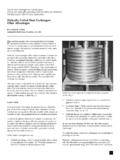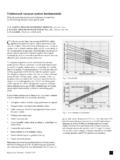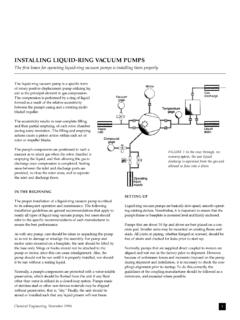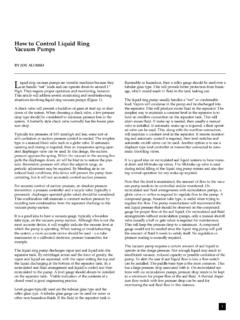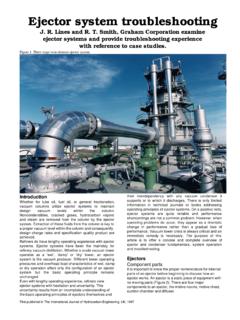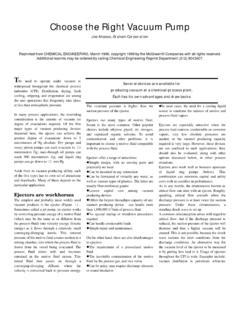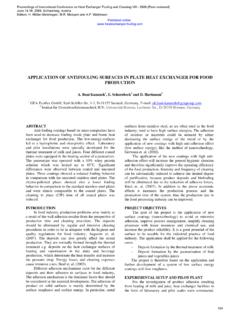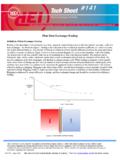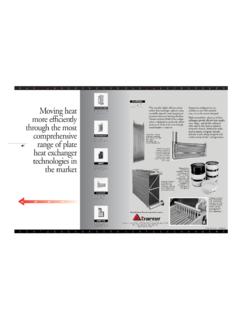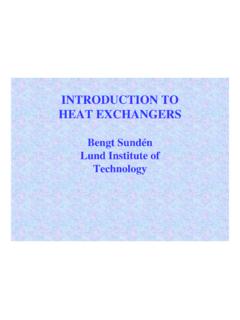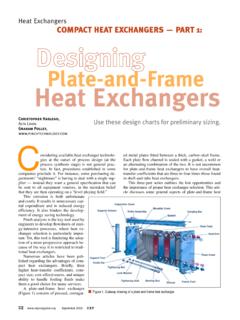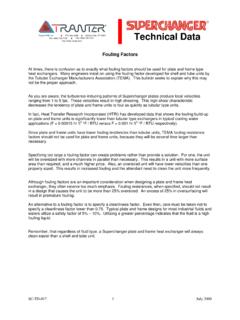Transcription of Heat Exchangers in Municipal Wastewater …
1 Retrofit projects at Wastewater treatment plants are fertileground for two special types of heat Exchangers in Municipal Wastewater treatment plants BY JAMES R. LINESThe majority of today s Wastewater treatment plants utilizea n a e robic digestion techniques for biological stabilization ofmunicipal sewage sludge. These plants which today are an integralp a rt of any community are tremendous consumers of energy Wi t henergy costs constantly on the rise and consumption closely moni-t o red, existing plants , some of them re t rofitted, and new plantsalike are installing plate and spiral heat Exchangers in an effort toreduce energy consumption, and so improve operating type, however, is considered for very different reasons.
2 Plateheat Exchangers may be selected for their high thermal efficiencyand minimum capital investment. Spiral heat Exchangers , on theother hand, are turned to for their ability to effectively handle flu-ids containing solids and fibers, similar to those encountered inwastewater treatment time users will want to become familiar with the basic con-struction features, advantages, limitations and applications ofthese heat familiar with the heat Exchangers may find some freshinformation regarding their installation or heat exc h a n g e r sin their normal orientation are true countercurrent flow heat Exchangers , with hot and cold fluids flowing inopposite directions relative to each other.
3 Basically, each exchang-er is an assembly of two long strips of metallic plate wrappedaround a mandrel to form a pair of concentric , alternate edges of the passages are welded closed so flu-ids flow through continuous, isolated channels. Fluid crosscontamination is not possible under normal passage spacing is maintained primarily by sealing barsmounted at the passage edge and spacing studs. Depending onthe fluid handled, the spacing may range from 1/4 to 1 1/4 .Certain designs do not contain spacing studs, such as unitsapplied to handle sewage sludge. The lack of spacing studsreduces the likelihood of plugging. Depending on thermal andpressure drop requirements, passage width may range from 9 to96.
4 Covers with full face gaskets are fitted to each side of theunit. Complete units are available from 5 ft 2 to 3000 ft of fabrication may be carbon steel, 304SS,316SS, Lgrade stainless, Alloy 20, Alloy 400, Alloy 200, as well as manyother weldable and cold workable material. For Wastewater treat-ment plants , however, carbon steel and stainless steel havenormally been sufficient. General guideline for pressure and tem-perature limitations are 150 PSIG and 800 heat exchanger advantages: passage spacing can be as large as 1 1/4 , allowing sewagesludge to be handled each fluid flows through a single uniform passage, eliminat-ing maldistribution and localized low velocity areas fluid flow is fully counter current for optimal thermal efficiency covers may be removed.
5 Exposing the heat transfer surface forinspection and/or cleaning compact design requires less space than a conventional heatexchanger spiral passage promotes turbulence and induces a scrubbingaction which lowers the fouling heat Exchangers Plate heat Exchangers consist of a series of thin corrugated platessuspended from a carrying bar and clamped between a fixed and amovable head plate. The corrugated plates, or heat transfer plates,are normally 304SS or 316SS; however, other materials can beused. Each heat transfer plate is fitted with an elastomeric gasket,partly to seal and partly to distribute process fluids. Connectionsin the fixed or movable head plate permit entry of process fluidsinto the plate heat transfer plates have spaces between them which formchannels for fluid flowThe hot and cold fluids are distributedthrough alternate channels in a counter current counter current geometry allows temperature crosses to beeffectively managed for maximum thermal channelformed by two adjacent plates is three dimensional in nature andAbout the AuthorJames R.
6 Lines is sales engineer of GrahamManufacturing Co., Inc. in Houston, the key to the plate heat exchanger s high threedimensional flow pattern induces turbulence at very low Reynoldsnumbers, and when coupled with a relatively small hydraulicdiameter, results in very high heat transfer rates. Since the platelength is relatively short, optimizing allowable pressure drop iseasily transfer plates can be arranged in a variety of configurations,with the standard being a single pass arrangement. When it isnecessary to improve thermal efficiency, plates may be arranged intwo, three or more guidelines for pressure and temperature limitations are250 PSIG and 350 deg.
7 heat exchanger advantages: design produces high thermal efficiency, allowing maximumheat recovery compact design requires a fraction of the space taken up byconventional heat Exchangers unit may be expanded to accommodate future increasedduties cross contamination not possible under normal operation;possible leaks are vented external to the unit access to heat transfer surface for maintenance is simple design exhibits low fouling tendency unit is economical to operateDIGESTER SLUDGE HEATING APPLICATIONThe primary application for spiral heat Exchangers is digestersludge heating. Digester temperature must be maintained withintight tolerances for proper sludge stabilization, approximately 95deg.
8 F for mesophilic digestion. Hot water heats the digestersludge as it is circulated through a spiral heat exchanger beforereturning to the spiral design must take into losses through the digester walls, roof and heat required to bring incoming raw sludge to allowance for heat input from the digestion process,which is heat Exchangers are ideally suited for this service. Digestersludge contains approximately 4wt percent solids and fibers,which tend to plug conventional heat SLUDGE PREHEATING APPLICATIONRaw sludge preheating with spiral heat Exchangers is accom-plished by recovering waste heat from digested sludge and using itto preheat the raw sludge before it enters the digester.
9 Duringcolder periods of the year, the raw sludge feed to the digester maybe 45 to 50 F. Using the heat available in the digested sludge,which leaves the digester at approximately 95 degrees, to preheatthe raw sludge greatly reduces the size and operating cost of thedigester sludge counter current spiral arrangement allows efficient and eco-nomic heat re c ove ry; 60 percent re c ove ry is nominal. Ad d i t i o n a l l y,the spiral is capable of handling these solid and fiber laden RING VACUUM PUMP SEAL COOLER Methane gas generated during the digestion process can be com-p ressed with a liquid ring vacuum pump and sent back to thed i g e s t e r.
10 The compressed gas bubbles up through the sludge and aidsin agitation and mixing. To re m ove the heat of compression and dis-sipate heat generated by the pump, re c i rculated seal water must becooled. A plate heat exc h a n g e r, using city water or tower water, maybe applied as the seal cooling system Plate heat Exchangers are com-pact are economical, and re q u i re little service water for WATER COOLERSV arious pieces of equipment such as diesel and gas engines requirejacket water cooling. Closed loop water can be used to reject theheat from these engines and plate heat Exchangers fed with cool-ing tower or city water may be installed to cool the closed loopjacket water.
